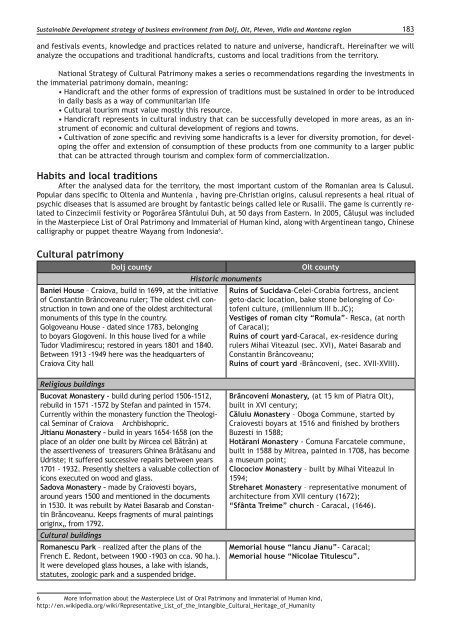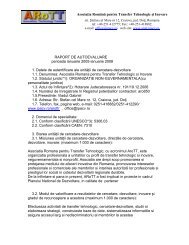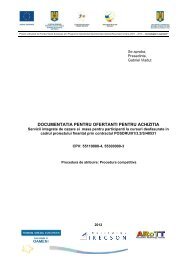182Sustainable Development strategy of business envi<strong>ro</strong>nment f<strong>ro</strong>m Dolj, Olt, Pleven, Vidin and Montana regionFor Olt county we mention: Magura Grădiștei – p<strong>ro</strong>montory located int the West of Slatina municipality, haggardfund (boars, <st<strong>ro</strong>ng>de</st<strong>ro</strong>ng>ers, rabbits, pheasants and partridges) and thermo mineral waters of chlor-alkali type, veryconcentrated, with temperature a<strong>ro</strong>und 55° C, point out by drills in Potcoava, Oporelu and Scornicești communes.In the two counties are found p<strong>ro</strong>tected area of avifauna type or communitarian sites that are part ofNatura 2000 Network.The total surface occupied by Natura 2000 sites in Dolj county is 147.189,4 ha, meaning a<strong>ro</strong>und 19,87%f<strong>ro</strong>m the county surface. There are 7 Natura 2000 sites out of which 4 are Special Areas of Avifauna P<strong>ro</strong>tectionand occupies a surface of 56.502,4 ha (7,62% f<strong>ro</strong>m the county surface) and 3 sites of communitarian importance(90.687 ha, respectively 12,24% f<strong>ro</strong>m the county surface).Based on the GD. no. 1284/31.10.2007 – regarding <st<strong>ro</strong>ng>de</st<strong>ro</strong>ng>claration of special areas of avifauna p<strong>ro</strong>tection, asintegrated art of Eu<strong>ro</strong>pean Ecological Netwok Natura 2000 in Romania, in Dolj were <st<strong>ro</strong>ng>de</st<strong>ro</strong>ng>clared the following SPA(au fost <st<strong>ro</strong>ng>de</st<strong>ro</strong>ng>clarate următoarele SPA (Special areas of Avifauna P<strong>ro</strong>tection):• ROSPA0010 Bistret (27.482,3 ha)• ROSPA0023 Confluence Jiu – Danube (40.730,9 ha)• ROSPA0074 Maglavit (3.562,6 ha)In Olt County we notice a number of 12 Natura sites 2000 and 3 Special Areas of Avifauna P<strong>ro</strong>tectionamong which one is divi<st<strong>ro</strong>ng>de</st<strong>ro</strong>ng>d with Dolj county.• ROSPA0023 Jiu – Danube confluence• ROSPA0024 Olt – Danube confluence• ROSPA 106 Oltului Inferior Olt ValleyUntil year 1980 in Olt County it was signalized the presence of bustard, the biggest flying bird f<strong>ro</strong>m the world,specific to Danube Plain area. In year 2005 were signalized some lost specimens, in the West part of the country, thatis assumed that came f<strong>ro</strong>m national parks f<strong>ro</strong>m Hungary where it was implemented a p<strong>ro</strong>ject for int<strong>ro</strong>duction andconservation of this species. In the situation of the analysed territory this species is consi<st<strong>ro</strong>ng>de</st<strong>ro</strong>ng>red vanished.At Bulgaria level, according to Law regarding the p<strong>ro</strong>tected area (Official Bulletin no. 133/1998), are <st<strong>ro</strong>ng>de</st<strong>ro</strong>ng>signatednational interest areas in or<st<strong>ro</strong>ng>de</st<strong>ro</strong>ng>r to p<strong>ro</strong>tect the biodiversity and the natural p<strong>ro</strong>cess within the ecosystems. Incompliance with the law p<strong>ro</strong>visions we can i<st<strong>ro</strong>ng>de</st<strong>ro</strong>ng>ntify: reservations and natural parks, natural monuments, p<strong>ro</strong>tectedsites. In the Danube area of Bulgaria we encounter 3 natural reservations where the human activity is not allowed,a natural monument, a reservation un<st<strong>ro</strong>ng>de</st<strong>ro</strong>ng>r the administration (with activities for conservation) and 4 p<strong>ro</strong>tected sites.For the three Bulgarian districts, part of the analysed region, we i<st<strong>ro</strong>ng>de</st<strong>ro</strong>ng>ntify important sites that were <st<strong>ro</strong>ng>de</st<strong>ro</strong>ng>clarednational reservations. Therefore, in Pleven district it is found the Natural Reservation “Chernelka”, an unique combinationof natural and archaeological elements. It localised in the central part of the lowland Danube, at app<strong>ro</strong>ximate12 km f<strong>ro</strong>m Pleven. It has a surface of 7 km, in which rivers give birth to a spectacular landscape – Karst canyon – witha wi<st<strong>ro</strong>ng>de</st<strong>ro</strong>ng> f<strong>ro</strong>m 60 to 200 m and an elevation of <strong>ro</strong>ck ring f<strong>ro</strong>m 10 to 30 m. The specific vegetation and rich fauna ma<st<strong>ro</strong>ng>de</st<strong>ro</strong>ng>the area to be <st<strong>ro</strong>ng>de</st<strong>ro</strong>ng>clared natural reservation of natural interest starting with year 1969.In Montana district we found the p<strong>ro</strong>tected area Kopren (with ecological tracks), Mishin Kamak cave and aseries of waterfalls.On the Vidin district territory is Natural reservation of Chuprene biosphere, recognized within theUNESCO P<strong>ro</strong>gramme.Architectural and cultural patrimonyAs shown in the National Strategy of Cultural Patrimony, the patrimony is an important factor in keepingthe i<st<strong>ro</strong>ng>de</st<strong>ro</strong>ng>ntity of cultural values and national, of sustainable <st<strong>ro</strong>ng>de</st<strong>ro</strong>ng>velopment, cohesion and social inclusion 5 . Accordingto the same strategy, the cultural patrimony is divi<st<strong>ro</strong>ng>de</st<strong>ro</strong>ng>d between real estate patrimony represented byconstructed patrimony (archaeological and architectural monuments), mobile cultural patrimony (museums,archives and collections) and immaterial patrimony (all the different cultural aspects of life inherited f<strong>ro</strong>m thepast that <st<strong>ro</strong>ng>de</st<strong>ro</strong>ng>fine the way of life of different societies).Real estate Cultural Patrimony (constructed patrimony)According to the same strategy „the real estate cultural patrimony is the most valuable component ofcultural patrimony, both concerning the direct material value and in comparison with the insertion possibilityof different extra cultural components.Immaterial cultural patrimony comprises the ensemble of all practices, representations, expressions,knowledge, abilities that communities, individual g<strong>ro</strong>ups recognize them as part of cultural inheriting, conveyedf<strong>ro</strong>m generation to generation and continues recreated. The immaterial cultural patrimony is found especiallyin the following domains:: traditions and oral expressions, art of performances, social practices, rites5 National Strategy of Cultural Patrimony, pg. 5, available at http://www.cultura.<strong>ro</strong>/Files/GenericFiles/MCC-StrategiaPCN.pdf
Sustainable Development strategy of business envi<strong>ro</strong>nment f<strong>ro</strong>m Dolj, Olt, Pleven, Vidin and Montana region 183and festivals events, knowledge and practices related to nature and universe, handicraft. Hereinafter we willanalyze the occupations and traditional handicrafts, customs and local traditions f<strong>ro</strong>m the territory.National Strategy of Cultural Patrimony makes a series o recommendations regarding the investments inthe immaterial patrimony domain, meaning:• Handicraft and the other forms of expression of traditions must be sustained in or<st<strong>ro</strong>ng>de</st<strong>ro</strong>ng>r to be int<strong>ro</strong>ducedin daily basis as a way of communitarian life• Cultural tourism must value mostly this resource.• Handicraft represents in cultural industry that can be successfully <st<strong>ro</strong>ng>de</st<strong>ro</strong>ng>veloped in more areas, as an instrumentof economic and cultural <st<strong>ro</strong>ng>de</st<strong>ro</strong>ng>velopment of regions and towns.• Cultivation of zone specific and reviving some handicrafts is a lever for diversity p<strong>ro</strong>motion, for <st<strong>ro</strong>ng>de</st<strong>ro</strong>ng>velopingthe offer and extension of consumption of these p<strong>ro</strong>ducts f<strong>ro</strong>m one community to a larger publicthat can be attracted th<strong>ro</strong>ugh tourism and complex form of commercialization.Habits and local traditionsAfter the analysed data for the territory, the most important custom of the Romanian area is Calusul.Popular dans specific to Oltenia and Muntenia , having pre-Christian origins, calusul represents a heal ritual ofpsychic diseases that is assumed are b<strong>ro</strong>ught by fantastic beings called Iele or Rusalii. The game is currently relatedto Cinzecimii festivity or Pogorârea Sfântului Duh, at 50 days f<strong>ro</strong>m Eastern. In 2005, Căluşul was inclu<st<strong>ro</strong>ng>de</st<strong>ro</strong>ng>din the Masterpiece List of Oral Patrimony and Immaterial of Human kind, along with Argentinean tango, Chinesecalligraphy or puppet theatre Wayang f<strong>ro</strong>m Indonesia 6 .Cultural patrimonyDolj countyBaniei House – Craiova, build in 1699, at the initiativeof Constantin Brâncoveanu ruler; The ol<st<strong>ro</strong>ng>de</st<strong>ro</strong>ng>st civil constructionin town and one of the ol<st<strong>ro</strong>ng>de</st<strong>ro</strong>ng>st architecturalmonuments of this type in the country.Golgoveanu House - dated since 1783, belongingto boyars Glogoveni. In this house lived for a whileTudor Vladimirescu; restored in years 1801 and 1840.Between 1913 -1949 here was the headquarters ofCraiova City hallHistoric monumentsOlt countyRuins of Sucidava-Celei-Corabia fortress, ancientgeto-dacic location, bake stone belonging of Cotofeniculture, (millennium III b.JC);Vestiges of <strong>ro</strong>man city “Romula”- Resca, (at northof Caracal);Ruins of court yard-Caracal, ex-resi<st<strong>ro</strong>ng>de</st<strong>ro</strong>ng>nce duringrulers Mihai Viteazul (sec. XVI), Matei Basarab andConstantin Brâncoveanu;Ruins of court yard -Brâncoveni, (sec. XVII-XVIII).Religious buildingsBucovat Monastery – build during period 1506-1512,rebuild in 1571 -1572 by Stefan and painted in 1574.Currently within the monastery function the TheologicalSeminar of Craiova Archbishopric.Jitianu Monastery – build in years 1654-1658 (on theplace of an ol<st<strong>ro</strong>ng>de</st<strong>ro</strong>ng>r one built by Mircea cel Bătrân) atthe assertiveness of treasurers Ghinea Brătăsanu andUdriste; it suffered successive repairs between years1701 - 1932. Presently shelters a valuable collection oficons executed on wood and glass.Sadova Monastery – ma<st<strong>ro</strong>ng>de</st<strong>ro</strong>ng> by Craiovesti boyars,a<strong>ro</strong>und years 1500 and mentioned in the documentsin 1530. It was rebuilt by Matei Basarab and ConstantinBrăncoveanu. Keeps fragments of mural paintingsoriginx„ f<strong>ro</strong>m 1792.Cultural buildingsRomanescu Park – realized after the plans of theFrench E. Redont, between 1900 -1903 on cca. 90 ha.).It were <st<strong>ro</strong>ng>de</st<strong>ro</strong>ng>veloped glass houses, a lake with islands,statutes, zoologic park and a suspen<st<strong>ro</strong>ng>de</st<strong>ro</strong>ng>d bridge.Brâncoveni Monastery, (at 15 km of Piatra Olt),built in XVI century;Căluiu Monastery – Oboga Commune, started byCraiovesti boyars at 1516 and finished by b<strong>ro</strong>thersBuzesti in 1588;Hotărani Monastery - Comuna Farcatele commune,built in 1588 by Mitrea, painted in 1708, has becomea museum point;Clocociov Monastery – built by Mihai Viteazul in1594;Streharet Monastery – representative monument ofarchitecture f<strong>ro</strong>m XVII century (1672);“Sfânta Treime” church - Caracal, (1646).Memorial house “Iancu Jianu”- Caracal;Memorial house “Nicolae Titulescu”.6 More information about the Masterpiece List of Oral Patrimony and Immaterial of Human kind,http://en.wikipedia.org/wiki/Representative_List_of_the_Intangible_Cultural_Heritage_of_Humanity





